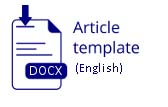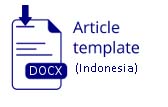PREDICTING LOAN ELIGIBILITY WITH SUPPORT VECTOR MACHINE: A MACHINE LEARNING APPROACH
Abstract
Abstract: Non-performing loans remain one of the main challenges faced by cooperatives, particularly when the loan eligibility assessment process is still conducted manually. This traditional approach tends to be time consuming, subjective, and prone to inaccurate decisions. This study aims to develop a predictive model for borrower eligibility using the Support Vector Machine (SVM) algorithm as a more efficient and objective machine learning-based solution. A total of 1,000 loan history records were processed using RapidMiner software, taking into account variables such as salary, years of employment, loan amount, monthly installment, employment status, monthly expenses, number of dependents, housing status, age, and collateral value. The model’s performance was evaluated using a confusion matrix and classification metrics including accuracy, precision, recall, and kappa. The results indicate that the SVM model achieved an accuracy of 90.05%, precision of 90.13%, recall of 90.05%, and f1 score of 90,08%, reflecting a strong performance in classifying borrower eligibility. The application of this method makes a significant contribution to the development of data driven decision support systems within cooperative environments. This finding expands the scientific understanding in the field of microfinance and supports the implementation of artificial intelligence technologies in making decisions that are more precise, rapid, and accurate.
Keywords: cooperative; eligibility prediction; machine learning; non-performing loan; SVM
Abstrak: Kredit macet merupakan salah satu permasalahan utama yang dihadapi koperasi, terutama ketika proses penilaian kelayakan peminjam masih dilakukan secara manual. Pendekatan ini cenderung lambat, subjektif, dan berisiko menghasilkan keputusan yang kurang akurat. Penelitian ini bertujuan untuk membangun model prediksi kelayakan peminjam menggunakan algoritma Support Vector Machine (SVM) sebagai solusi berbasis machine learning yang lebih efisien dan objektif. Sebanyak 1.000 data riwayat pinjaman diolah menggunakan tools RapidMiner dengan mempertimbangkan variabel: gaji, lama bekerja, besar pinjaman, angsuran per bulan, status pegawai, pengeluaran bulanan, jumlah tanggungan, status rumah, umur, dan nilai jaminan. Evaluasi model dilakukan menggunakan confusion matrix dan metrik klasifikasi seperti akurasi, presisi, recall, dan kappa. Hasil menunjukkan bahwa model SVM mencapai akurasi 90,05%, presisi 90,13%, recall 90,05%, dan f1 score 90,08%, yang mencerminkan performa model yang sangat baik dalam mengklasifikasikan kelayakan peminjam. Penerapan metode ini memberikan kontribusi penting dalam pengembangan sistem pendukung keputusan berbasis data di lingkungan koperasi. Temuan ini memperluas wawasan keilmuan di bidang keuangan mikro dan mendukung penerapan teknologi kecerdasan buatan dalam pengambilan keputusan yang lebih tepat, cepat, dan akurat.
Kata Kunci: koperasi; kredit macet; machine learning; prediksi kelayakan; SVM
References
S. Riyadi, M. M. Siregar, K. fadhli F. Margolang, and K. Andriani, “Analysis of SVM and Naive Bayes Algorithm In Classification of Nad Loans in save and Loan Cooperatives,” JURTEKSI (Jurnal Teknol. dan Sist. Informasi), vol. 8, no. 3, pp. 261–270, Aug. 2022, doi: 10.33330/jurteksi.v8i3.1483.
N. K. H. Aripuspa, N. M. Estiyanti, and E. M. Dharma, “Model Sistem Pendukung Keputusan Kelayakan Pemberian Kredit Pada BUMDes,” Progresif J. Ilm. Komput., vol. 18, no. 2, p. 231, Jul. 2022, doi: 10.35889/progresif.v18i2.925.
S. Sandiwarno, “Penerapan Machine Learning Untuk Prediksi Bencana Banjir,” J. Sist. Inf. Bisnis, vol. 14, no. 1, pp. 62–76, Jan. 2024, doi: 10.21456/vol14iss1pp62-76.
A. Prawira, D. Arisandi, and T. Sutrisno, “Penerapan Algoritma Naive Bayes dan Multiple Linear Regression Untuk Prediksi Status dan Plafon Kredit (Studi Kasus: Bank ABC),” J. Educ., vol. 5, no. 1, pp. 1075–1087, Dec. 2022, doi: 10.31004/joe.v5i1.720.
I. M. D. P. Asana and N. P. D. T. Yanti, “Sistem Klasifikasi Pengajuan Kredit Dengan Metode Support Vector Machine (SVM) I Made Dwi Putra Asana,” J. Sist. Cerdas, vol. 6, no. 2, pp. 123–133, 2023.
H. Yuliansyah, S. Sulistyawati, T. W. Sukesi, S. A. Mulasari, and W. N. S. Wan Ali, “Artificial intellige nce in malnutrition research: a bibliometric analysis,” Bull. Soc. Informatics Theory Appl., vol. 7, no. 1, pp. 32–42, Jul. 2023, doi: 10.31763/businta.v7i1.605.
A. Bagja, K. Kusrini, and M. R. Arief, “Komparasi Algoritma Naïve Bayes Dan SVM Untuk Klasifikasi Kelayakan Pemberian Pinjaman,” Infotek J. Inform. dan Teknol., vol. 6, no. 2, pp. 513–523, Jul. 2023, doi: 10.29408/ jit.v6i2.20059.
E. Alaros, M. Marjani, D. A. Shafiq, and D. Asirvatham, “Predicting Consumption Intention of Consumer Relationship Management Users Using Deep Learning Techniques: A Review,” Indones. J. Sci. Technol., vol. 8, no. 2, pp. 307–328, Dec. 2022, doi: 10.17509/ijost.v8i2.55814.
N. Windy Mardiyyah, N. Rahaningsih, and I. Ali, “Penera pan Data Mining Menggunakan Algoritma K-Nearest Neighbor Pada Prediksi Pemberian Kredit Di Sektor Finansial,” JATI (Jurnal Mhs. Tek. Inform., vol. 8, no. 2, pp. 1491–1499, Apr. 2024, doi: 10.36040/jati.v8i2.9010.
D. W. Sinaga, A. Z. Syah, and E. Saputra, “Implementasi Simple Multi Attribute Rating Technique untuk Menentukan Kelayakan Pengajuan Kredit Mobil,” Edumatic J. Pendidik. Inform., vol. 8, no. 1, pp. 203–211, Jun. 2024, doi: 10.29408/edumatic.v8i1.25687.
M. R. Wirasena and J. Warma nsyah, “Penerapan Algoritma C4.5 Untuk Prediksi Kelayakan Pengajuan Kartu Kredit Visa Bagi Nasabah,” TeknoIS J. Ilm. Teknol. Inf. dan Sains, vol. 14, no. 2, pp. 296–302, Jul. 2024, doi: 10.36350/jbs.v14i2.266.
R. Halila Nasution and S. Humaira, “Implementasi Algo ritma Naïve Bayes Untuk Mempre diksi Kelayakan Pemberian Kredit Sepeda Motor,” J. Sci. Soc. Res., vol. 4307, no. 2, pp. 546–554, 2024, doi: https://doi.org/10. 54314/jssr.v7i2.1872.
R. Wahyusari, D. P. Putro, P. S. Informatika, S. Tinggi, and T. Ronggolawe, “Penerapan Algorit ma K-Nearest Neighbor Untuk Penentuan Pemberian Kredit Application of the K-Nearest Neighbor Algorithm for Determi ning Credit,” pp. 1–5, 2024.
Islamia Nuraini, Arnowo Hari Wibowo, Muhammad Asrol, Taufik, and Dyah Lang Wilis, “Analisis Pemeliharaan Prediktif Kendaraan Operasional Mengguna kan Algoritma Naïve Bayes Dan Decision Tree,” J. Publicuho, vol. 7, no. 2, pp. 591–603, May 2024, doi: 10.35817/publicuho.v7i2.412.
A. Nata and S. Suparmadi, “Analisis Sistem Pendukung Keputusan Dengan Model Klasifikasi Berbasis Machine Learning Dalam Penentuan Penerima Program Indonesia Pintar,” J. Sci. Soc. Res., vol. 5, no. 3, p. 697, Oct. 2022, doi: 10.54314/jssr.v5i3.1041.
R. Pratama, M. I. Herdiansyah, D. Syamsuar, and A. Syazili, “Prediksi Customer Retention Perusahaan Asuransi Menggunakan Machine Learning,” J. Sisfokom (Sistem Inf. dan Komputer), vol. 12, no. 1, pp. 96–104, Mar. 2023, doi: 10.32736/sisfokom.v12i1.1507.
Y. Mulyana, A. Fadlil, and I. Riadi, “Classification of Organizational Data Using the K-Means Algorithm,” Komputasi J. Ilm. Ilmu Komput. dan Mat., vol. 19, no. 2, pp. 123–137, Jul. 2022, doi: 10.33751/komputasi.v19i2.5676.
H. Syahputra and A. Wibowo, “Comparison of Support Vector Machine (SVM) and Random Forest Algorithm for Detection of Negative Content on Websites,” J. Ilm. Tek. Elektro Komput. dan Inform., vol. 9, no. 1, pp. 165–173, Mar. 2023, doi: 10.26555/jiteki.v9i1.25861.
B. Prasojo and E. Haryatmi, “Analisa Prediksi Kelayakan Pemberian Kredit Pinjaman dengan Metode Random Forest,” J. Nas. Teknol. dan Sist. Inf., vol. 7, no. 2, pp. 79–89, Sep. 2021, doi: 10.25077/TEKNOSI.v7i2.2021.79-89.
H. Yuliansyah, Z. A. Othman, and A. A. Bakar, “A new link prediction method to alleviate the cold-start problem based on extending common neighbor and degree centrality,” Phys. A Stat. Mech. its Appl., vol. 616, p. 128546, Apr. 2023, doi: 10.1016/j.physa.2023.128546.
B. O. S. Miranda, H. Yuliansyah, and M. K. Biddinika, “Machine Translation Indonesian Bengkulu Malay Using Neural Machine Translation-LSTM,” IJCCS (Indonesian J. Comput. Cybern. Syst., vol. 18, no. 3, Jul. 2024, doi: 10.22146/ijccs.98384.
H. Yuliansyah, R. A. P. Imaniati, A. Wirasto, and M. Wibowo, “Predicting Students Graduate on Time Using C4.5 Algorithm,” J. Inf. Syst. Eng. Bus. Intell., vol. 7, no. 1, p. 67, Apr. 2021, doi: 10.20473/jisebi.7.1.67-73.
S. A. Koni’ah and H. Yuliansyah, “Classification Algorithm for Link Prediction Based on Generated Features of Local Similarity-Based Method,” SISTEMASI, vol. 11, no. 2, p. 317, May 2022, doi: 10.32520/stmsi.v11i2.1641.
I. S. Al-Mejibli, J. K. Alwan, and D. H. Abd, “The effect of gamma value on support vector machine performance with different kernels,” Int. J. Electr. Comput. Eng., vol. 10, no. 5, p. 5497, Oct. 2020, doi: 10.11591/ijece.v10i5. pp5497-5506.
S. Fide, S. Suparti, and S. Sudarno, “Analisis Sentimen Ulasan Aplikasi Tiktok Di Google Play Menggunakan Metode Support Vector Machine (Svm) Dan Asosiasi,” J. Gaussian, vol. 10, no. 3, pp. 346–358, Dec. 2021, doi: 10.14710/j.gauss.v10i3.32786.













